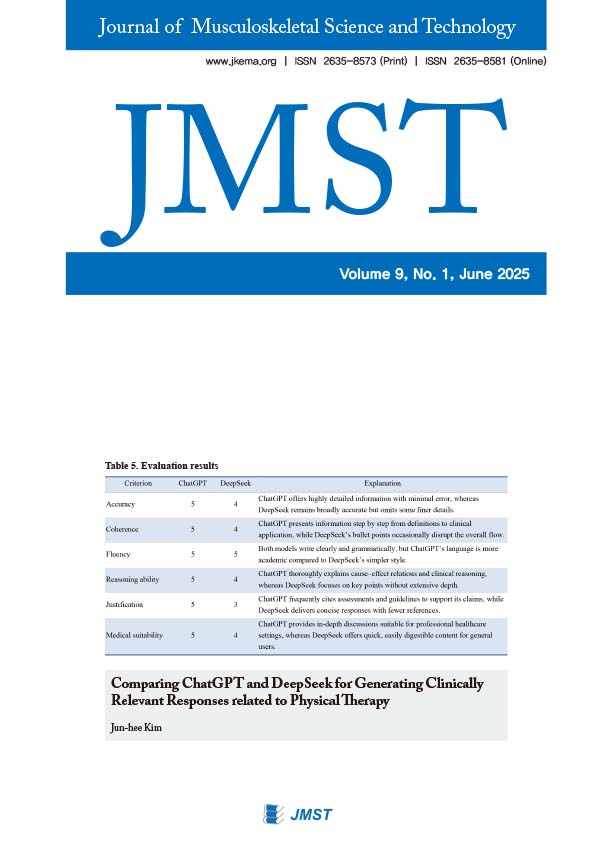학술논문
Supervised Machine Learning for Frailty Classification using Physical Performance Measures in Older Adults
이용수 0
- 영문명
- 발행기관
- KEMA학회
- 저자명
- Si-hyun Kim
- 간행물 정보
- 『Journal of Musculoskeletal Science and Technology』제9권 제1호, 36~43쪽, 전체 8쪽
- 주제분류
- 의약학 > 재활의학
- 파일형태
- 발행일자
- 2025.06.30
4,000원
구매일시로부터 72시간 이내에 다운로드 가능합니다.
이 학술논문 정보는 (주)교보문고와 각 발행기관 사이에 저작물 이용 계약이 체결된 것으로, 교보문고를 통해 제공되고 있습니다.

국문 초록
Background: Frailty is an important condition to detect in its early stages to prevent progression to more severe stages in older adults. Age-related declines in physical performance are strongly associated with frailty.
Purpose: This study aims to develop a frailty classification model by comparing the performance of machine learning models based on physical performance measures in community-dwelling older adults.
Study design: A cross-sectional study
Methods: Physical performance data were collected from older adults aged ≥65 years. Frailty classification models were developed using logistic regression, support vector machine (SVM), K-nearest neighbors (KNN), decision tree, and random forest. Clinical features including short physical performance battery, single-leg stance, SARC-F, body mass index, and mini-mental state examination (MMSE) were used as input variables for model development. The performance of each model was evaluated using accuracy, sensitivity, specificity, precision, F1-score, and area under the receiver operating characteristic curve (AUC). Permutation feature importance was employed to identify key predictors of frailty.
Results: The KNN model demonstrated the highest classification performance, achieving an accuracy of 0.93, an F1-score of 0.95, and an AUC of 0.86, indicating its suitability for frailty assessment. The logistic regression model achieved an accuracy of 0.86, an F1-score of 0.89, and an AUC of 0.98. The random forest model showed similar results, with an accuracy of 0.86, an F1-score of 0.88, and an AUC of 0.96. The SVM model recorded an accuracy of 0.79, an F1-score of 0.84, and an AUC of 0.80. The decision tree model showed the lowest performance, with an accuracy of 0.71, an F1-score of 0.78, and an AUC of 0.64. Feature importance analysis revealed that MMSE and SARC-F were the most influential predictors in the KNN model.
Conclusions: This study demonstrates that KNN is well-suited for identifying subtle variations in physical function that contribute to frailty. The results highlight its potential for clinical implementation in automated frailty screening. Feature importance analysis provides insight into key predictors, supporting personalized assessment strategies. However, due to the small sample size, further research is needed to assess the generalizability of frailty classification models in larger populations.
영문 초록
목차
INTRODUCTION
MATERIALS AND METHODS
RESULTS
DISCUSSION
CONCLUSION
REFERENCES
해당간행물 수록 논문
- Effects of Shoulder Horizontal Abduction with Thoracic Extension on Electromyography of Trapezius Muscles
- Supervised Machine Learning for Frailty Classification using Physical Performance Measures in Older Adults
- The Analysis of Gait Variables and Plantar Pressure Patterns in Community-Dwelling Elderly Patients with Hemiplegic Stroke
- Correlation Analysis between Shoulder Abduction Angles and Normalized Muscle Activity of Scapular Muscles during Y-Raise Exercise with Elastic Resistance
- Effects of a Hip Joint Muscle Strengthening Program using Props on Lower Limb Alignment and Balance in Older Adults
- Relationships among Sleep Quality, Postural Alignment, Muscle Strength, and Psychological Health in Healthy Adults
- Effects of Hip Joint Closed Kinetic Chain Exercises on Static and Dynamic Balance according to Support Surface in Physical Education Entrance Exam Students with Functional Ankle Instability
- Effects of Sit-to-Stand Exercise combined with Joint Mobilization with Movement on Lower Extremity Functions, Balance, and Gait Performance in Patients with Chronic Stroke
- The Effects of Wall Squat Exercise using Elastic Band on Leg Strength, Gait, and Plantar Pressure in Chronic Stroke Patients
- Comparative Effects of Leaflet- and Video-Guided Core Stabilization Exercises on Juvenile Idiopathic Scoliosis
- Influences of Metatarsal Toe Orthosis on 3D Kinematic Pelvic Motion during Gait in Individuals with Morton Foot Syndrome
- Comparing ChatGPT and DeepSeek for Generating Clinically Relevant Responses related to Physical Therapy
- Comparison of Gluteus Maximus, Biceps Femoris, and Multifidus Muscle Activity and Heart Rate Variability between Bridge and Sling Bridge Exercises in Individuals with Non-Specific Low Back Pain
참고문헌
관련논문
의약학 > 재활의학분야 BEST
- 중증정신질환자가 이용하는 지역사회 정신건강서비스에 대한 체계적 고찰
- 인지행동치료가 조현병 환자의 자아존중감에 미치는 영향에 대한 체계적 고찰
- 조현병 환자에게 적용한 그룹인지재활프로그램이 인지기능과 작업적 참여에 미치는 효과
의약학 > 재활의학분야 NEW
- Effects of Shoulder Horizontal Abduction with Thoracic Extension on Electromyography of Trapezius Muscles
- Supervised Machine Learning for Frailty Classification using Physical Performance Measures in Older Adults
- The Analysis of Gait Variables and Plantar Pressure Patterns in Community-Dwelling Elderly Patients with Hemiplegic Stroke
최근 이용한 논문
교보eBook 첫 방문을 환영 합니다!

신규가입 혜택 지급이 완료 되었습니다.
바로 사용 가능한 교보e캐시 1,000원 (유효기간 7일)
지금 바로 교보eBook의 다양한 콘텐츠를 이용해 보세요!




